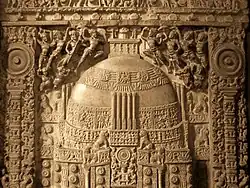Amaravati art
Amaravati school of art is an ancient Indian art style that evolved in the region of Amaravati (then known as Dhānyakaṭaka) in the modern-day Andhra Pradesh from 2nd century BCE to the end of the 3rd century CE.[1][2][3] It is also called the Andhra School or Vengi School.[2] Art historians regard the art of Amaravati as one of the three major styles or schools of ancient Indian art, the other two being the Mathura style, and the Gandharan style.[4][5]
  Top: Amaravati Maha Stupa relief, 1st–2nd century CE; Bottom: Limestone railing pillar from Amaravati | |
| Years active | 2nd century BCE–3rd century CE |
|---|---|
In addition to the ruins at Amarāvati, the style is also seen in the stupa remains at Jaggayyapeta, Nagarjunakonda, Ghantasala, and Goli, in Andhra Pradesh, and as far west as Ter, Maharashtra.[6] Largely because of the maritime trading links of the East Indian coast, the Amaravati school of sculpture had great influence on art in South India, Sri Lanka (as seen at Anuradhapura) and South-East Asia.[7][1][2][5][8]
Characteristics
Buddha image in sculptures which later on became the prototype of images in different Buddhist countries was standardised here.[5][6] The Amaravati style of Buddha image retained its popularity in Sri Lanka till the 12th century.[6]
See also
References
- "Amarāvatī sculpture". Encyclopedia Britannica. Retrieved 25 March 2023.
- V. D., Mahajan (2016). Ancient India. S. Chand Publishing. pp. 294, 295. ISBN 978-93-5253-132-5.
- Kumari, Sabita (2012). "Representation of the Birth of the Buddha in Buddhist Art of Andhradesa". Proceedings of the Indian History Congress. 73: 163–168. ISSN 2249-1937. JSTOR 44156202.
- Pal, Pratapaditya (1986). Indian Sculpture: Circa 500 B.C.-A.D. 700. Los Angeles County Museum of Art. p. 154. ISBN 978-0-520-05991-7.
- Jermsawatdi, Promsak (1979). Thai Art with Indian Influences. Abhinav Publications. pp. 48, 49. ISBN 978-81-7017-090-7.
- Ramachandran, A. “Amaravati Buddhist Images in Sri Lanka and Southeast Asia.” Proceedings of the Indian History Congress, vol. 53, 1992, pp. 686–91. JSTOR, JSTOR 44142888. Accessed 27 Mar. 2023.
- Rowland 1967, p. 210
- Chowdhuri, Sreyashi Ray (24 October 2022). "Impact of Amarāvatī on early schools of art of South-East Asia". University of Calcutta. Retrieved 27 March 2023 – via Wisdom Library.
Bibliography
- Rowland, Benjamin (1967). The Art and Architecture of India: Buddhist, Hindu, Jain (3rd ed.). Pelican History of Art, Penguin. ISBN 0140561021.
External link
 Media related to Amaravati art at Wikimedia Commons
Media related to Amaravati art at Wikimedia Commons